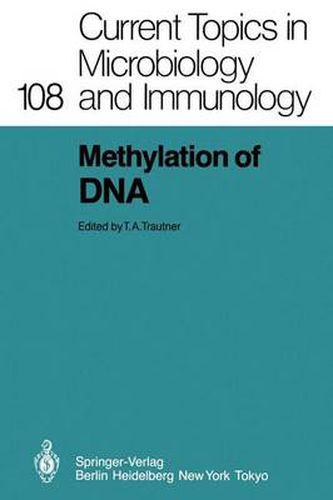Readings Newsletter
Become a Readings Member to make your shopping experience even easier.
Sign in or sign up for free!
You’re not far away from qualifying for FREE standard shipping within Australia
You’ve qualified for FREE standard shipping within Australia
The cart is loading…






This title is printed to order. This book may have been self-published. If so, we cannot guarantee the quality of the content. In the main most books will have gone through the editing process however some may not. We therefore suggest that you be aware of this before ordering this book. If in doubt check either the author or publisher’s details as we are unable to accept any returns unless they are faulty. Please contact us if you have any questions.
Postreplicative methylation of bacterial DNA has long been known to be the molecular basis of modification, which protects DNA against destruction by restriction endonucleases. More recently, another function of DNA methylation was found in Escherichia coli, where methy- lation is involved during DNA replication in the recogni- tion of old and newly synthesized strands. The intensive search for new restriction enzymes during the 1970s yielded an enormous arsenal of such enzymes and re- vealed the ubiquitous distribution of restriction/modifi- cation systems in the bacterial kingdom without provid- ing much information on the corresponding modifica- tion methyltransferases. However, it is obvious that DNA methyltransferases represent an ideal class of en- zymes to those interested in protein/DNA interactions; these enzymes are at least as interesting as the restriction enzymes, with which they share the capacity to recognize and interact with specific sequences of DNA. In recent years the interest in DNA methylation has been greatly stimulated by two discoveries: the correla- tion between gene expression and hypomethylation in eukaryotes and the convertability of DNA into its Z form through cytosine methylation. In fact, studies on DNA methylation are now being intensively performed in many laboratories. A description of the state of the art of DNA methylation has been the topic of two con- gresses: The Cologne Spring Meeting in 1981 organized by WALTER DOERFLER and an EMBO Workshop at Nethybridge in 1982 organized by ROGER ADAMS.
$9.00 standard shipping within Australia
FREE standard shipping within Australia for orders over $100.00
Express & International shipping calculated at checkout
Stock availability can be subject to change without notice. We recommend calling the shop or contacting our online team to check availability of low stock items. Please see our Shopping Online page for more details.
This title is printed to order. This book may have been self-published. If so, we cannot guarantee the quality of the content. In the main most books will have gone through the editing process however some may not. We therefore suggest that you be aware of this before ordering this book. If in doubt check either the author or publisher’s details as we are unable to accept any returns unless they are faulty. Please contact us if you have any questions.
Postreplicative methylation of bacterial DNA has long been known to be the molecular basis of modification, which protects DNA against destruction by restriction endonucleases. More recently, another function of DNA methylation was found in Escherichia coli, where methy- lation is involved during DNA replication in the recogni- tion of old and newly synthesized strands. The intensive search for new restriction enzymes during the 1970s yielded an enormous arsenal of such enzymes and re- vealed the ubiquitous distribution of restriction/modifi- cation systems in the bacterial kingdom without provid- ing much information on the corresponding modifica- tion methyltransferases. However, it is obvious that DNA methyltransferases represent an ideal class of en- zymes to those interested in protein/DNA interactions; these enzymes are at least as interesting as the restriction enzymes, with which they share the capacity to recognize and interact with specific sequences of DNA. In recent years the interest in DNA methylation has been greatly stimulated by two discoveries: the correla- tion between gene expression and hypomethylation in eukaryotes and the convertability of DNA into its Z form through cytosine methylation. In fact, studies on DNA methylation are now being intensively performed in many laboratories. A description of the state of the art of DNA methylation has been the topic of two con- gresses: The Cologne Spring Meeting in 1981 organized by WALTER DOERFLER and an EMBO Workshop at Nethybridge in 1982 organized by ROGER ADAMS.